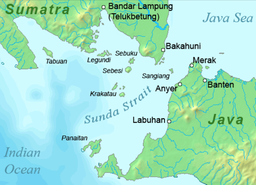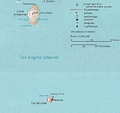
Krakatoa, also transcribed Krakatau, is a caldera in the Sunda Strait between the islands of Java and Sumatra in the Indonesian province of Lampung. The caldera is part of a volcanic island group comprising four islands. Two, Lang and Verlaten, are remnants of a previous volcanic edifice destroyed in eruptions long before the famous 1883 eruption; another, Rakata, is the remnant of a much larger island destroyed in the 1883 eruption.
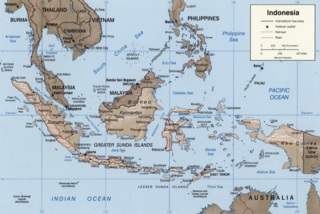
The Sunda Arc is a volcanic arc that produced the volcanoes that form the topographic spine of the islands of Sumatra, Nusa Tenggara, and Java, the Sunda Strait and the Lesser Sunda Islands. The Sunda Arc begins at Sumatra and ends at Flores, and is adjacent to the Banda Arc. The Sunda Arc is formed via the subduction of the Indo-Australian Plate beneath the Sunda and Burma plates at a velocity of 63–70 mm/year.
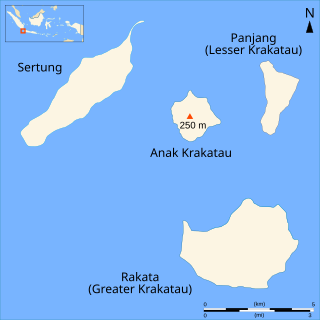
Rakata, also called Greater Krakatau, is a partially collapsed and uninhabited stratovolcano on the Indonesian island of Krakatoa in the Sunda Strait between the islands of Sumatra and Java. Standing 813 m (2,667 ft) tall, it was the largest and southernmost of three volcanoes that formed the island Krakatoa and the only one not totally destroyed in the 1883 eruption. Rakata is the last remnant of the original island prior to its destruction. However, Rakata did lose its northern half in that eruption, leaving just its southern half. The exposed cliff is quite striking visually, partially of a large exposed dike terminating in a large lenticular extrusion at the middle of the almost vertical cliff. The feature has been called "the Eye of Krakatoa."

Anak Krakatoa is a volcanic island in Indonesia. On 29 December 1927, Anak Krakatoa first emerged from the caldera formed in 1883 by the explosive volcanic eruption that destroyed the island of Krakatoa. There has been sporadic eruptive activity at the site since the late 20th century, culminating with a large underwater collapse of the volcano that caused a deadly tsunami in December 2018. There has been subsequent activity since. Due to its young age, the island is one of several in the area that are of interest to, and the subject of extensive study by, volcanologists.

Port of Merak is a seaport located in the Pulo Merak District of the city of Cilegon, Banten, on the northwestern tip of Java, Indonesia. The port and district are named after the green peafowl, which once lived in the region, but now only lives in the nearby Ujung Kulon National Park. The port is connected to Jakarta via the Jakarta-Merak Toll Road and is also connected to the Bakauheni port which is located at the south of the Trans-Sumatran Highway.
Lang Island lies in the Sunda Strait, between Java and Sumatra, in Indonesia. It is one of the Krakatoa Archipelago, above the famous Krakatoa volcano. Lang suffered only slightly in the 1883 eruption of Krakatoa; it actually grew in area from massive pumice fall, although most of the additional area washed away within several years.
Perboewatan was one of the three main volcanic cones on the island of Krakatoa, in the Sunda Strait, in Indonesia. It was the lowest and northernmost of the cones. Perboewatan was completely destroyed during the 1883 eruption; the caldera is approximately 820 feet (250 m) deep at its former location.
Danan was one of the three volcanic cones on the island of Krakatoa, in the Sunda Strait, in Indonesia. It stood 450 metres (1,480 ft), lay in the central area of the island, and may have been a twin volcano. Danan was almost entirely destroyed in the 1883 eruption of Krakatoa; only a rocky islet named Bootsmansrots remains of it.
Verlaten Island is an island that was likely created in the AD 535 eruption of Krakatoa. It is located in the Sunda Strait in Indonesia, between Java and Sumatra. It is part of the Krakatoa Archipelago, above the famous Krakatoa volcano. Other than some minor collapse in the southeast, Verlaten suffered little damage in the 1883 eruption. Instead, it grew almost three times in area due to pumice fall, although most of the gain was quickly eroded away.

Anyer, also known as Anjer or Angier, is a coastal town in Banten, formerly West Java, Indonesia, 82 miles (100 km) west of Jakarta and 15 kilometers (9 mi) south of Merak. A significant coastal town late 18th-century, Anyer faces the Sunda Strait.
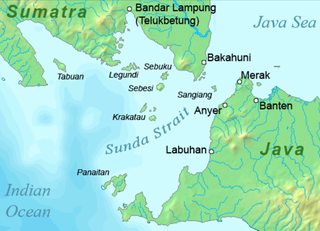
Sebesi is an Indonesian island in the Sunda Strait, between Java and Sumatra, and part of the province of Lampung. It rises to a height of 844 metres (2,769 ft) and lies about 12 kilometres (7.5 mi) north of the Krakatoa Archipelago; it is the closest large island to Krakatoa, about the same area and height as the remnant of Rakata. Like Krakatoa, it too is volcanic, although no dated eruptions are known. Unlike the Krakatoa Archipelago, Sebesi has permanent streams and is inhabited. Habitation is concentrated most heavily on the northern and eastern coasts of the island.

Panaitan is an island in the Sunda Strait, between Java and Sumatra, and in the Indonesian province of Banten. It is the largest island in the strait, and is located near the westernmost tip of Java. Like the nearby Krakatoa, it too is volcanic in origin, although there are no known historic eruptions. The name 'Prince's Island' apparently is because the island was considered the property of Javan princes. Administratively, the island is a part of Pandeglang Regency.

Sebuku is an island in the Sunda Strait between Java and Sumatra. It is one of the larger islands in the strait and lies just 2.5 km (1.6 mi) to the north of Sebesi and 2.3 kilometres (1.4 mi) south of Sumatra. It is administratively part of South Lampung Regency, Lampung.

The 1883 eruption of Krakatoa in the Sunda Strait occurred from 20 May until 21 October 1883, peaking in the late morning hours of 27 August when over 70% of the island of Krakatoa and its surrounding archipelago were destroyed as it collapsed into a caldera.

South Lampung Regency is a regency of Lampung, Sumatra, Indonesia, a strip of land surrounding the provincial capital of Bandar Lampung on its northern and eastern sides, and bounded to the west by the new Pesawaran Regency and to the south by the Sunda Strait; as such it is a major transit corridor to/from Java island. It has an area of 2,109.74 km2, and a population of 909,989 at the 2010 census and 1,064,301 at the 2020 census; the official estimate as at mid 2022 was 1,081,115. The regency seat is the town of Kalianda.

The 2018 Sunda strait tsunami occurred on 22 December 2018 at around 21:38 local time after large parts of the southwestern side of Anak Krakatoa collapsed onto its caldera. The landslide spawned a massive tsunami wave that struck multiple coastal regions in Banten and Lampung, including the popular tourist destination of Anyer.

The Krakatoa Archipelago is a small uninhabited archipelago of volcanic islands formed by the Krakatoa stratovolcano located in the Sunda Strait, nestled between the much larger islands of Java and Sumatra. As of 2018, the archipelago consists of four main islands: Verlaten, Lang, Rakata, and the currently volcanically active Anak Krakatoa. Together, the islands are a part of the Indonesian island arc system, created by the northeastward subduction of the Indo-Australian Plate. As part of a dynamic volcanic system, the islands have been continuously reshaped throughout recorded history, most notably in the 1883 eruption of Krakatoa.

Heptapleurum polybotryum is a species of shrub in the family Araliaceae. They are scrambling shrubs or trees native to Java and southern Sulawesi.

